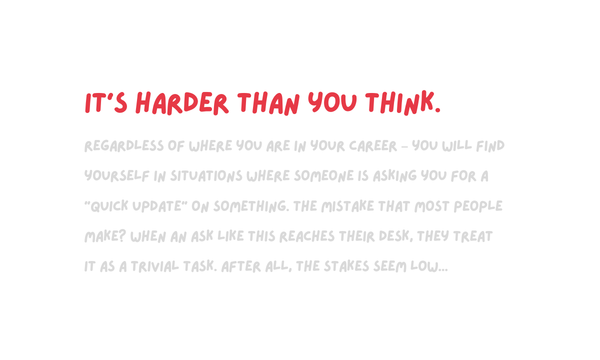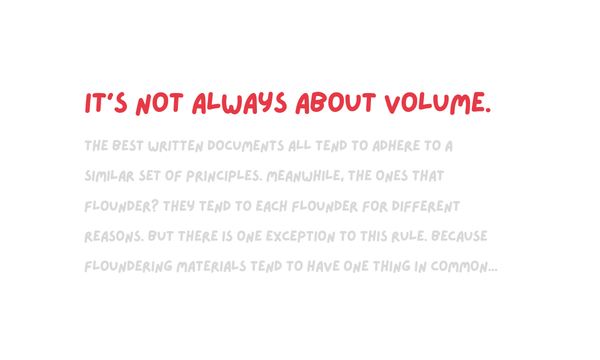When not saying what you mean backfires
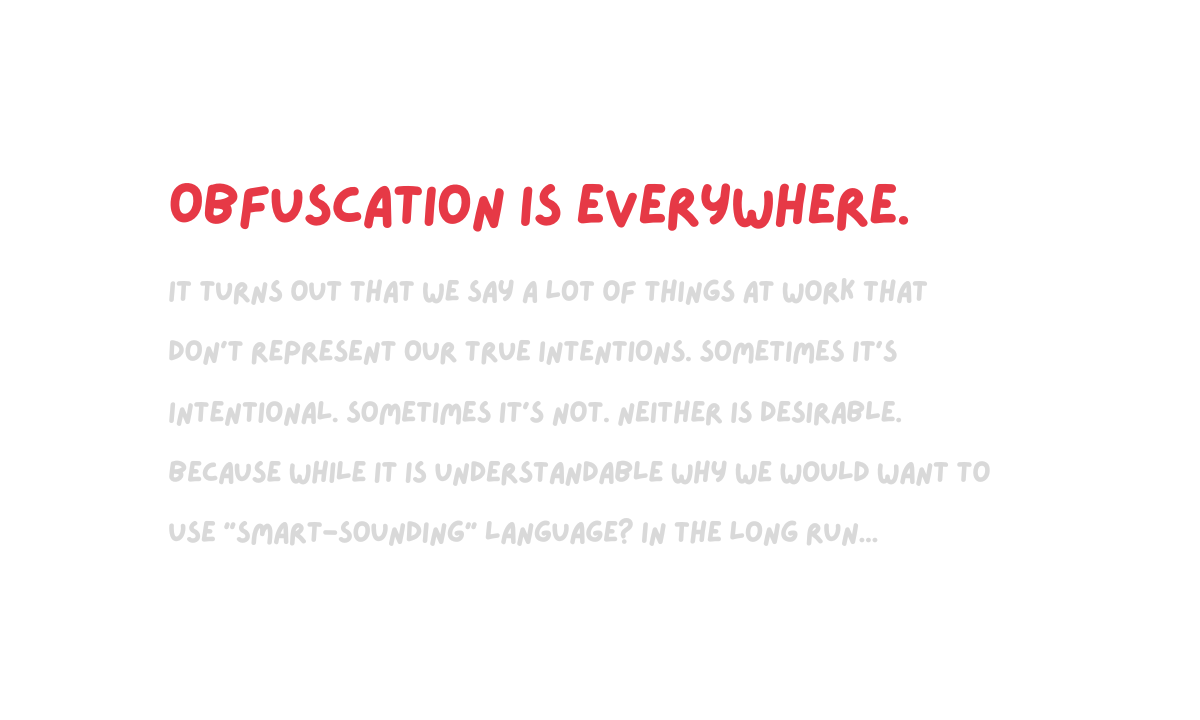
Many years ago, I remember reviewing a presentation I was working on with my manager.
As we went through the slides, my manager pointed at one of the talking points, and asked:
"You wrote that this market might see 'de-growth' – what does that mean?"
To which I said:
"Negative growth, no? Like a decline?"
My manager then looked at me with a funny expression, and asked:
"Then why wouldn't we just say that?"
But here's the thing: I wasn't the one that came up with the phrase "de-growth." I simply lifted it from one of the source materials I was referencing.
Sure, it struck me as an odd phrase, but I assumed it was being used for a valid reason. So I simply copied and pasted.
And I didn't realize how silly of a euphemism it was, until my manager pointed it out to me.
👋 Join 5000+ readers and subscribe to Herng's Newsletter for free:
Why do we obfuscate?
It turns out that we say a lot of things at work that don't represent our true intentions.
Sometimes it's intentional. Sometimes it's not. Neither is desirable.
Because while it is understandable why we would want to use "smart-sounding" language? In the long run, it simply obfuscates our message and dilutes our credibility.
Plus, no matter how much you try to "mask" your true intentions – people are wired to do that "translation" in their heads anyway.
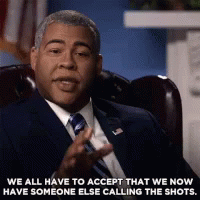
But here's the twist: using corpspeak isn't the only way through which we slowly blunder away our credibility. There are other things we do – sometimes unintentionally – that have the same effect.
And we'll talk through some of those examples today.
Mistake #1: Over-relying on euphemisms.
When I first started working, I wanted to sound credible and get taken seriously.
So over time, I discovered the world of corporate euphemisms. And I was fascinated. It was amazing how "professional" you could sound, simply by using different words to describe the same thing.
So instead of saying "removing unprofitable products?" I learned to say "product rationalization."
Instead of saying "I don't have time to do this?" I learned to say "I don't have bandwidth."
And instead of saying "I don't agree?" I learned to say "I'm not aligned."
While there was nothing wrong with learning the language of the corporate world, I also found instances where this led to unnecessary sugarcoating and obfuscation.
For instance:
- Instead of saying "reducing headcount?" You desensitize yourself and call it "org rightsizing."
- Instead of saying "this approach isn't working and we need a new one?" You brush off accountability and call it "pivoting."
- And instead of saying "we aren't doing as well as we could?" You ignore the underlying reasons and simply say there's "headroom to capture."
And when you cross that line – you end up with fuzzy thinking at best, and compromised integrity at worst.
Because you create a bubble for yourself where there's a false sense of control. You give yourself permission not to dig deeper and figure out what's really going on.
Over time, you'll also lose the ability to deliver bad news or voice unpopular opinions.
Corp-speak isn't deadly. But if you let it slowly chip away your ability to think critically, deeply, and honestly? Then it's a problem.
👋 Subscribe for free to get Herng's newsletter directly in your inbox.
Mistake #2: Forcing others to "translate."
Obfuscation isn't always about catchphrases or buzzwords.
It also occurs when you try to "soften the blow" with innocuous-sounding statements, not realizing it might actually backfire.
For instance, when you get a question from your audience, and you say:
"That's a great question, let's take it offline."
More often than not, others either hear:
"I don't want to answer that now."
Or they hear:
"I don't have a good answer, but I don't want to look dumb in front of others."
Or, consider this situation, where you send the following email to a colleague:
"Hi there! Per my last email from 2 weeks ago, we'll need inputs from your team on this project. Let me know if there's any issue – I happen to meet your team leader later this week on a separate topic, and can give them context as well. Thanks!"
Again, despite the "professional" and peppy language, most people will immediately register that you're simply saying:
"I asked for this a long time ago, and I'm going to escalate to your boss if I don't get an answer."
Of course, there's a glass-half-full way of looking at this, which is that the sanitized version is better than its raw, confrontational form.
But the issue with this? It's that you force people to do the "translation" in their own heads. And when that happens, things tend to escalate, as people will likely assume the worst narrative.
You then end up with unnecessary strife and distrust. And your attempt to "soften the blow" has now actually backfired.
My suggestion? Call a spade a spade. If something's not working, address it by leading with curiosity. For instance, say something like:
"Hi! We're getting close to the submission deadline but still don't have inputs from your team. Let me know if there's anything confusing regarding the process, and if there's anything else I can do to make it easier. Happy to jump on a quick call too!"
Indeed, more often that not, having a quick live discussion can usually help diffuse tension and sort things out quickly. Back-and-forth email debates rarely solve anything.
(Trust me – I learned this the hard way.)
Either way, just remember that you don't actually "soften the blow" by masking your true intentions with seemingly innocuous language. People can see right through it.
It's often counterproductive, and hurts your credibility over the long run.
👋 Subscribe for free to get Herng's newsletter directly in your inbox.
Mistake #3: Not curating your content.
The last few examples we looked at were mostly intentional attempts at obfuscation.
The next couple examples are the opposite. It's when we communicate one thing, yet unintentionally signal something else.
Let's look at a few examples.
Imagine that you're about to present an analysis to your stakeholders. To ensure your data integrity, you lead with the following slide:
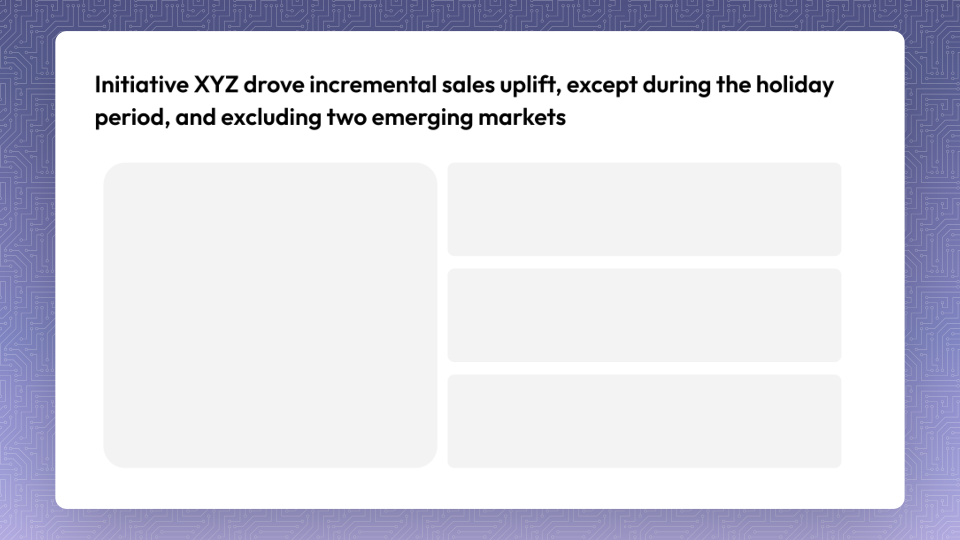
While the messaging in this slide is factual and intellectually honest – it is sending the wrong signal.
Because while you think you're saying:
"This is a robust analysis, and I want to give you all the caveats up front."
Your audience hears:
"This analysis is patchy at best, since there are so many caveats."
Let me be clear: it's not that you have to hide your caveats to inspire confidence. That's intellectually dishonest.
Instead, it's that if you're not intentional about sequencing and real estate? You simply confuse your audience.
Because consider how much sharper your message would be with the following framing (while still ensuring data integrity):
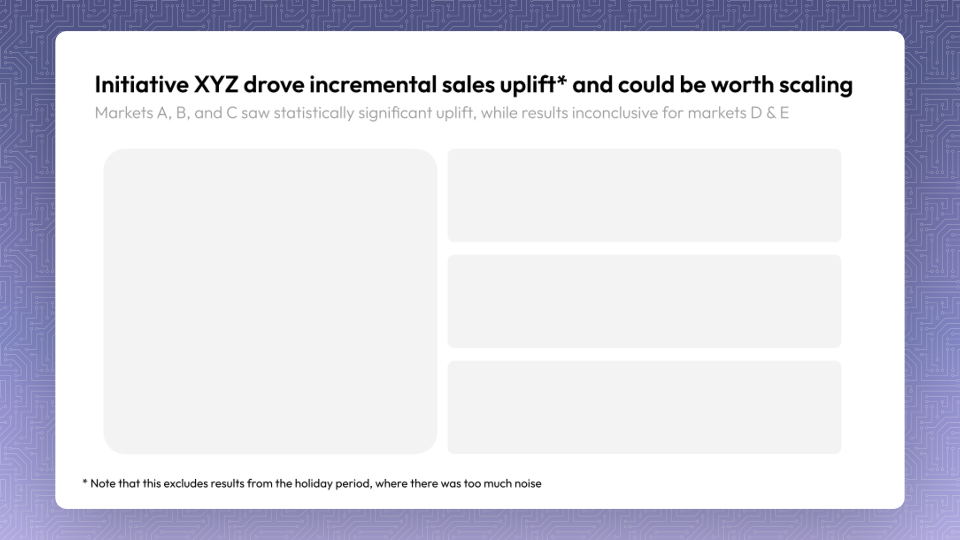
Did we hide anything or twist the truth? Not really. We simply found a way to balance sharpness with nuance, by properly curating and sequencing our messaging.
And we're no longer sabotaging ourselves with unintended obfuscation.
(Related read: how to avoid self-sabotage from unintentional signaling)
Let's look at another example. It turns out that obfuscation can also occur if you don't curate your data.
For example, consider the following slide:
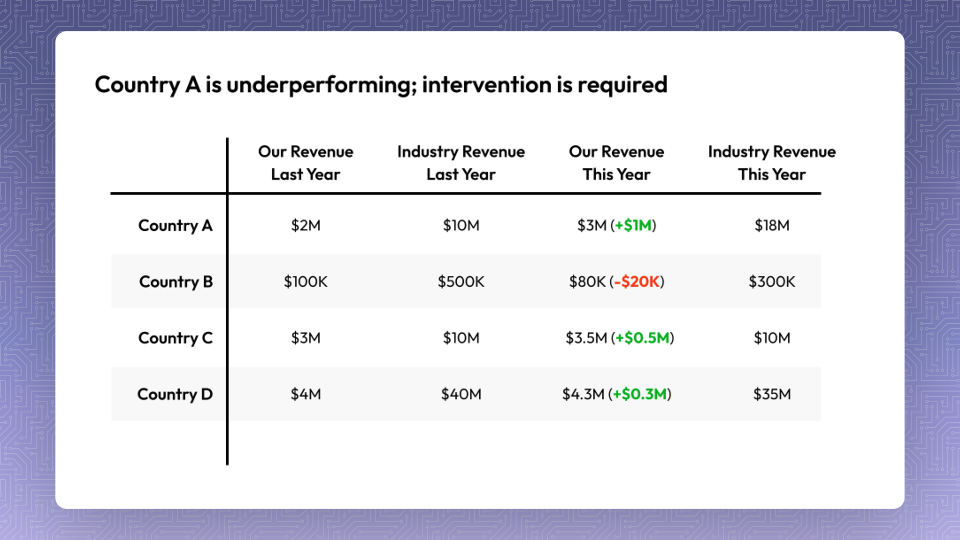
The issue with this slide? Well, for starters:
- The headline contradicts the content. Because isn't Country A the one with the highest absolute revenue growth (+$1M)? How could it be "underperforming?"
- The color-coding only adds to the confusion. Country B seems to be the odd one out. So why is Country A the one singled out?
But if the same set of data was properly curated? It could then be framed in a much more intuitive way, e.g. –
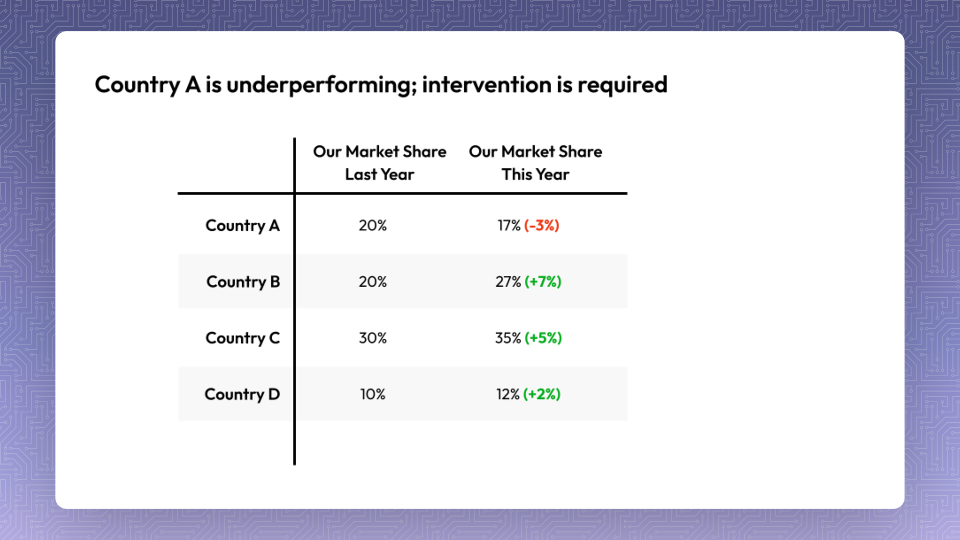
There. It's the same set of data, but it's simpler and sharper. And now the storyline actually makes sense.
And you're no longer confusing your audience.
Quick Takeaways
- We engage in obfuscation at work more often than we think.
- When intentional: it can lead to lazy thinking or hurt relationships.
- When unintentional: we confuse our audience and lose credibility.

